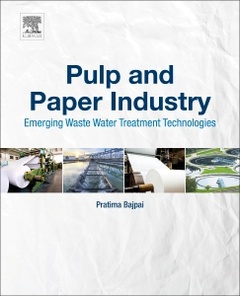Pulp and Paper Industry Emerging Waste Water Treatment Technologies
Auteur : Bajpai Pratima

Pulp and Paper Industry: Emerging Waste Water Treatment Technologies is the first book which comprehensively reviews this topic. Over the past decade, pulp and paper companies have continued to focus on minimizing fresh water use and effluent discharges as part of their move towards sustainable operating practices. Three stages?basic conservation, water reuse and water recycling?provide a systematic approach to water resource management. Implementing these stages requires increased financial investment and better utilization of water resources.
The ultimate goal for pulp and paper companies is to have effluent-free factories with no negative environmental impact. The traditional water treatment technologies that are used in paper mills are not able to remove recalcitrant contaminants. Therefore, advanced water treatment technologies are being included in industrial wastewater treatment chains aiming to either improve water biodegradability or its final quality.
This book discusses various measures being adopted by the pulp and paper industry to reduce water consumption and treatment techniques to treat wastewater to recover it for reuse. The book also examines the emerging technologies for treatment of effluents and presents examples of full-scale installations.
1. Introduction 2. The pulp and paper industry3. Best available techniques (BAT) 4. Water use in pulp and paper processes 5. Measures to reduce water consumption6. Current external wastewater treatment7. Emerging waste water treatment technologies8. Examples of full-scale installations9. Future perspectives
This book will be a valuable resource for Pulp and Paper Technologist/ Engineers, Senior Paper Scientists, Applied Chemists, Chemical Engineers, Environmental Scientists and Engineers. Professionals, Academics, Analysts, Consultants
- Provides thorough and in-depth coverage of advanced treatment technologies which will benefit the industry personnel, pulp manufacturers, researchers and advanced students
- Presents new treatment strategies to improve water reuse and fulfill the legislation in force regarding wastewater discharge
- Presents viable solutions for pulp and paper manufacturers in terms of wastewater treatment
- Presents examples of full-scale installations to help motivate mill personnel to incorporate new technologies
Date de parution : 03-2017
Ouvrage de 228 p.
19x23.3 cm
Thème de Pulp and Paper Industry :
Mots-clés :
Activated sludge; Advanced oxidation processes (AOPs)Emerging technologies; Advanced oxidation processes; Advanced oxidation; Aerated lagoon; Aerobic; Anaerobic treatment; Anaerobic; Best available techniques; Biofiltration; Biological oxygen demand (BOD)Chemical oxygen demand (COD)Corporate Responsibility for Environmental Protection (CREP)Integrated Pollution Prevention and Control (IPPC) directive; Bleaching; Chemical precipitation; Chemical recovery; Dry debarking; Effluent quality; Elemental chlorine-free (ECF) bleaching; Emerging technologies; Emissions; Environmental effects; Enzymes; External treatment; Flocculation; FlooBed bioreactor process; Full-scale installation; Future perspectives; In-pulp mill water conservation; Integration of water systems/application of pinch technology; Internal circulation reactor; Keyword; Management of paper machine wastewater; Membrane bioreactor (MBR)Research needs; Membrane processes; Microorganisms; Modification of pulping and bleaching processes; Moving bed bioreactor (MBR)Primary treatment; Nanofiltration; Paper recycling; Papermaking; Per capita paper consumption; Process modification; Pulp and paper consumption; Pulp and paper industry; Pulp and paper mills; Pulp and paper production; Pulping; Recycled fiber processing; Reduction of water consumption; Secondary treatment; Separation of process and nonprocess waters; Sequential biotreatment; Stock preparation; System closure; Tertiary treatment; Total chlorine-free (TCF) bleaching; Ultrafiltration; Wastewater treatment; Water consumption; Water recovery; Water reuse; Water use; Wood preparation



